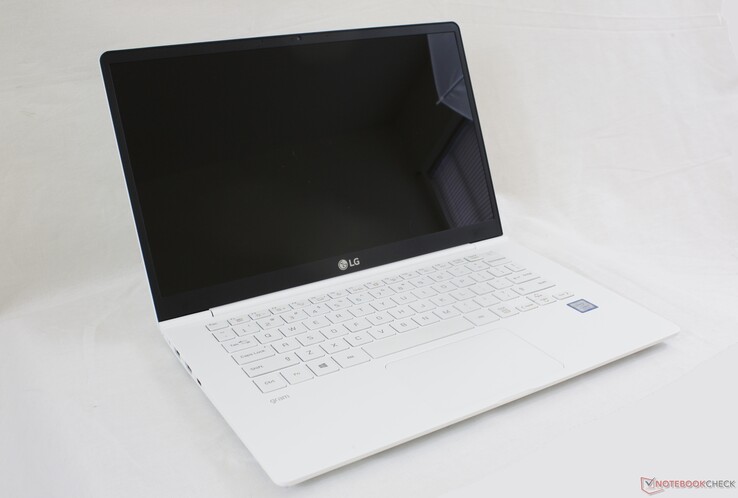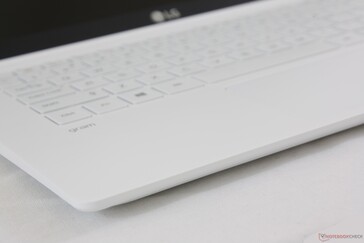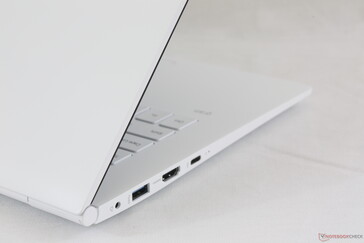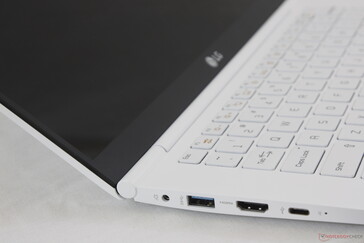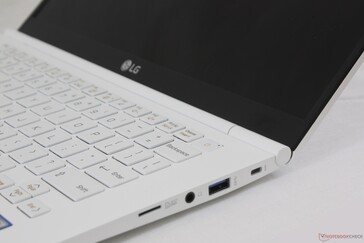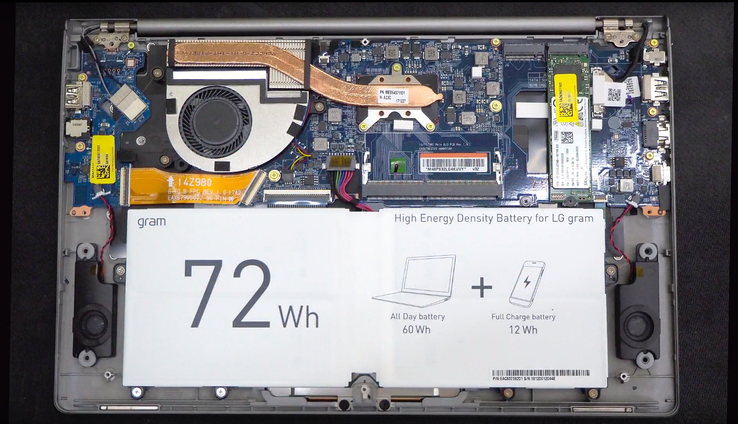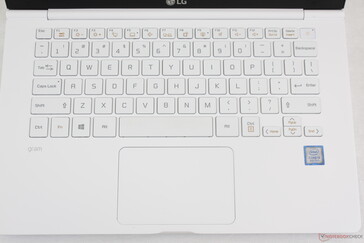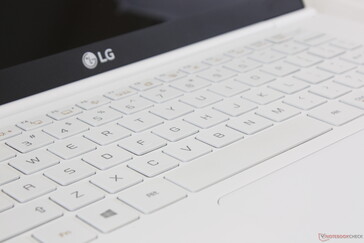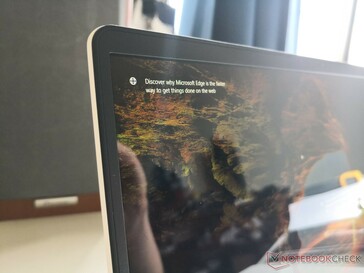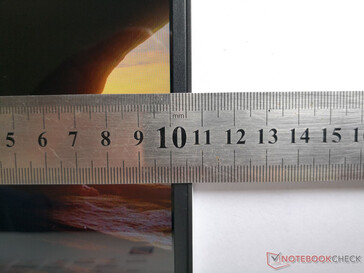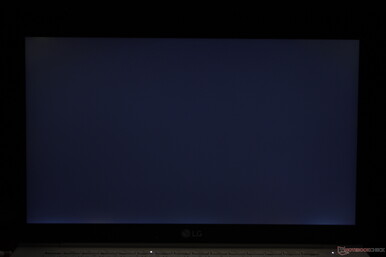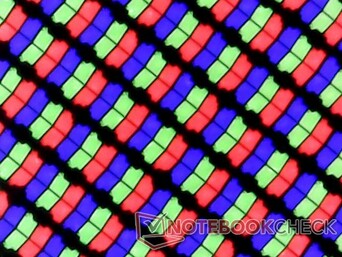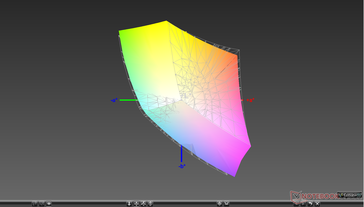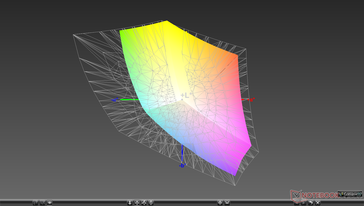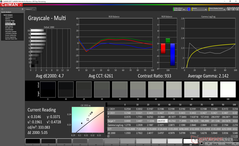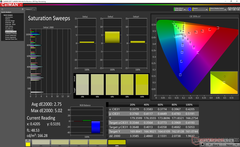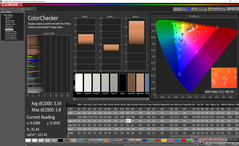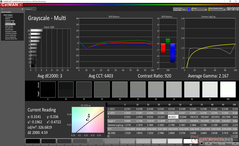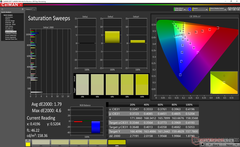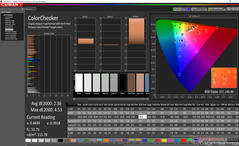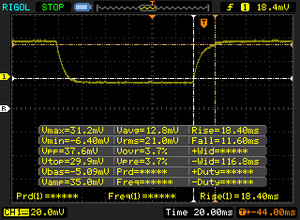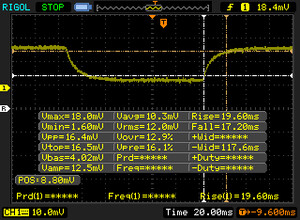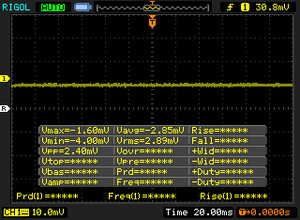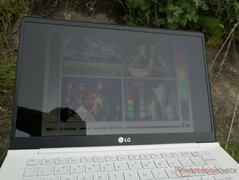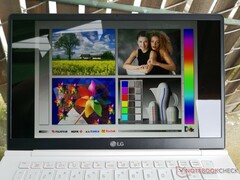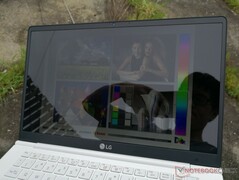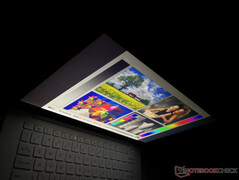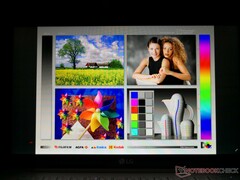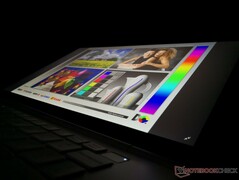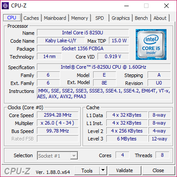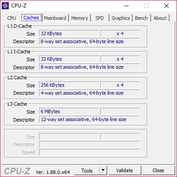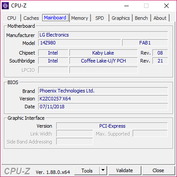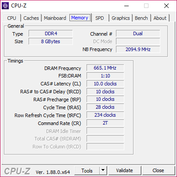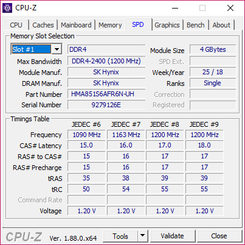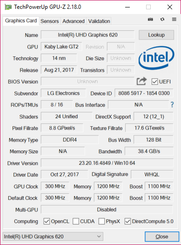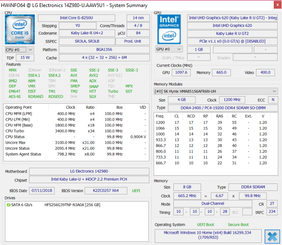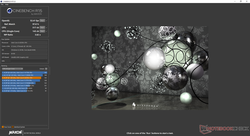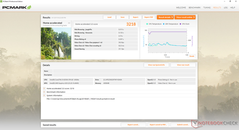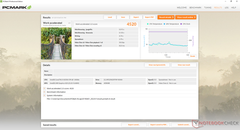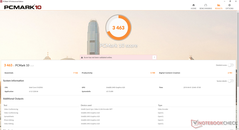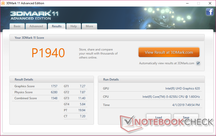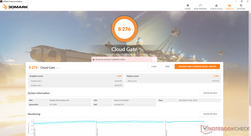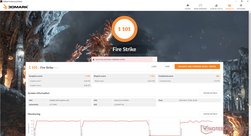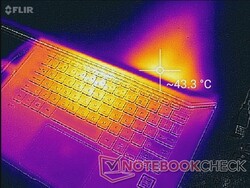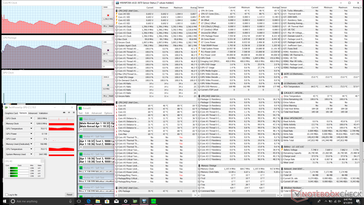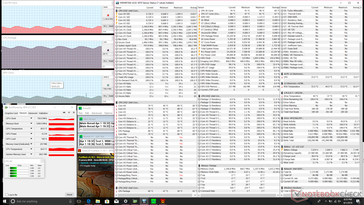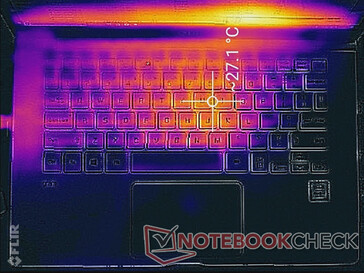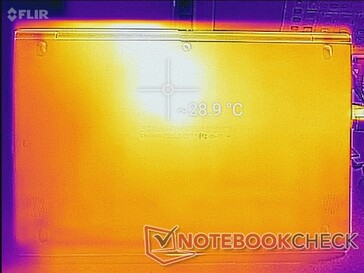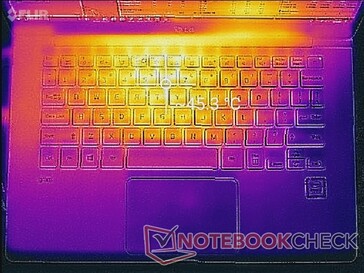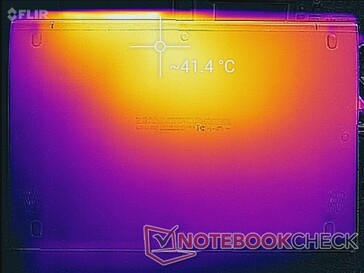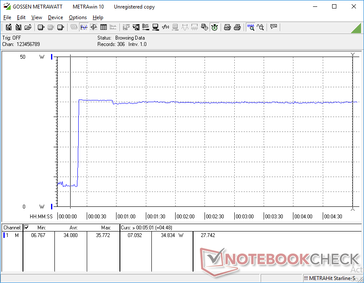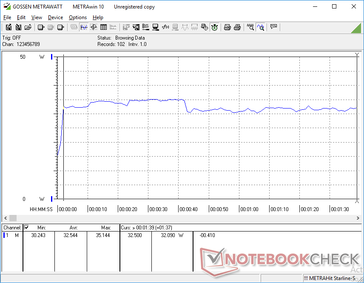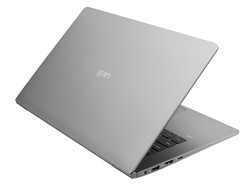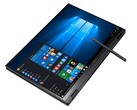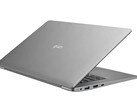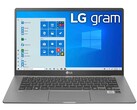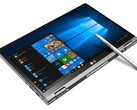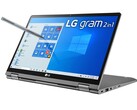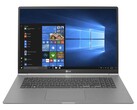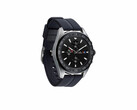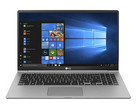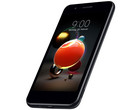LG Gram 14Z980 (i5-8250U) Laptop Review
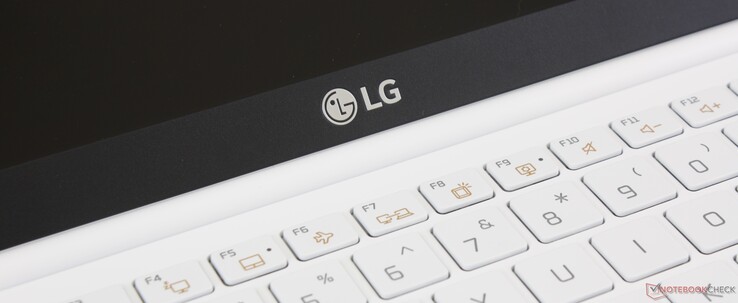
The 14-inch Gram 14 is part of LG's Gram series of mainstream-flagship Ultrabooks. True to its name, Gram laptops prioritize being as lightweight as possible — often at the cost of reduced features and luxuries found on most other competing Ultrabooks.
All Gram laptops as of this writing share similar design qualities and characteristics. Thus, we recommend checking out our existing reviews on the 13.3-inch Gram 13 and 15.6-inch Gram 15 for more information on what the series has to offer. The Gram 14 we have here today is the entry-level SKU equipped with a Core i5-8250U CPU and 256 GB M.2 SSD for $1000 USD. A higher-end SKU with the Core i7-8550U and 512 GB SSD is also available for $1300 USD, but the 1080p glossy display, UHD Graphics 620, and 8 GB of RAM are identical between both configurations.
The Gram 14 competes directly with other mainstream 14-inch Ultrabooks including the Honor Magicbook, Lenovo Yoga C930, IdeaPad 530s, Asus ZenBook 14, Acer Swift 3, Huawei MateBook X Pro, and the MateBook 14.
(April 5, 2019 update: The Gram 14 does indeed support USB Type-C charging. The feature is disabled out-of-the-box and so it must be re-enabled through the LG Control Center software. We're able to charge the laptop with a third-party 65 W AC adapter thereafter. Any statements about the lack of USB Type-C charging have been removed from this page.)
(April 10, 2019 update: LG lists its Gram 14Z980 as having an M.2 SATA interface. While we can't confirm if our test unit can support NVMe, we now know that some SKUs appear to support NVMe SSDs and speeds.)
More LG Gram reviews:
Case
The "nano carbon magnesium" body promises MIL-STD 810G certification against shock, high and low temperatures, dust, vibration, and more as detailed on the official product page. When held, the base feels sturdy especially given how light it weighs. Attempting to twist the base from its edges results in only minor warping and creaking for a very good first impression. The center of the keyboard is slightly more flexible to pressure, but it's not enough to be of any real concern during use. We find the base to be just a step below the XPS 13, Spectre 13, and Blade Stealth in terms of rigidity.
By far the weakest part of the chassis is its lid. Much like on the Gram 13 and Gram 15, the lid of the Gram 14 is more susceptible to flexing than on most competing Ultrabooks. We attribute this to the lack of Gorilla Glass reinforcement and very thin outer lid. The lid on the super-light Samsung Notebook 9 NP900X5T suffers from the same issue as well.
Other than the drawbacks above, there's not much to dislike about the design. The milky white smooth matte surfaces of our test unit is excellent at hiding fingerprints and the bar hinge is firm enough to prevent teetering when typing. It could have been more taut for better longevity, but it's satisfactory nonetheless.
The low weight of just 994 g is the highlight of the Gram 14. This is about 16 to 30 percent lighter than other Ultrabooks including the Yoga C930, Zenbook 14, and MateBook X Pro. Even smaller 13.3-inch Ultrabooks like the XPS 13 or Spectre 13 are several hundred grams heavier than the LG. Overall dimensions of the Gram 14, however, are otherwise ordinary for a narrow bezel 14-inch laptop. As a result, it lacks the same dense and heavy impressions of the aforementioned 13.3-inch alternatives.
Connectivity
Ports and port positioning are identical to the Gram 13. The main disadvantage continues to be the lack of Thunderbolt 3 which limits the docking capabilities of the system. Its sole USB Type-C port appears to be limited to Gen. 1 speeds (5 Gbps) as well.
It's disappointing to see that the Gram 14 still includes a proprietary AC adapter port. Most Ultrabooks have already made the transition to USB Type-C charging only including the HP Spectre 13 or Lenovo Yoga C930.
The HDMI port is very likely v1.4 and not v2.0 as we are able to output to native 4K at 30 Hz instead of 60 Hz.
SD Card Reader
Much like the Gram 13 and Gram 15, the Gram 14 integrates a spring-loaded MicroSD card reader limited by a maximum transfer rate of about 85 MB/s. Transferring 1 GB worth of photos from our UHS-II test card to desktop takes about 14 seconds compared to 6 seconds on the XPS 13.
A fully inserted MicroSD card protrudes about 1 mm for easy ejecting.
| SD Card Reader | |
| average JPG Copy Test (av. of 3 runs) | |
| Lenovo ThinkPad X1 Carbon 2018-20KGS03900 (Toshiba Exceria Pro M501) | |
| Dell XPS 13 9380 2019 (Toshiba Exceria Pro SDXC 64 GB UHS-II) | |
| LG Gram 14Z980-U.AAW5U1 (Toshiba Exceria Pro M501 microSDXC 64GB) | |
| Asus Zenbook 14 UX433FN-A6023T (Toshiba Exceria Pro M501 microSDXC 64GB) | |
| maximum AS SSD Seq Read Test (1GB) | |
| Lenovo ThinkPad X1 Carbon 2018-20KGS03900 (Toshiba Exceria Pro M501) | |
| Dell XPS 13 9380 2019 (Toshiba Exceria Pro SDXC 64 GB UHS-II) | |
| LG Gram 14Z980-U.AAW5U1 (Toshiba Exceria Pro M501 microSDXC 64GB) | |
| Asus Zenbook 14 UX433FN-A6023T (Toshiba Exceria Pro M501 microSDXC 64GB) | |
Communication
LG equips its Gram 14 with the older Intel 8265 whereas newer Ultrabooks are shipping with the faster Intel 9260. Thus, theoretical transfer rates and Bluetooth are limited to 867 Mbps and v4.1 versus 1.73 Gbps and v5 on competing systems. This fortunately has little to no impact on day-to-day browsing and streaming and we didn't experience any connectivity issues during our time with the unit.
| Networking | |
| iperf3 transmit AX12 | |
| Lenovo Yoga C930-13IKB | |
| Dell XPS 13 9380 2019 | |
| Huawei Matebook X Pro i5 | |
| LG Gram 14Z980-U.AAW5U1 | |
| iperf3 receive AX12 | |
| Huawei Matebook X Pro i5 | |
| LG Gram 14Z980-U.AAW5U1 | |
| Lenovo Yoga C930-13IKB | |
| Dell XPS 13 9380 2019 | |
Maintenance
The Gram series in general is not easily serviceable. The bottom panel is once again secured by several Philips screws hidden behind plastic covers and tightly glued rubber feet. Credit goes to the YouTuber here on how to properly remove the bottom plate.
Once inside, owners will have direct access to two M.2 storage bays and a single SODIMM slot. 4 GB to 8 GB of RAM is soldered onto the motherboard depending on the SKU. The vast amount of empty space surrounding the battery and relatively small cooling solution help to reduce the overall weight of the system.
Accessories and Warranty
LG includes a USB Type-A to RJ-45 adapter alongside the usual manuals. The adapter is limited to 10/100 Mbps and so it does not offer gigabit Ethernet speeds.
The standard one-year limited warranty applies. LG does not appear to offer any extended warranty options in the United States. Official manuals and drivers for the Gram 14 can be found here.
Input Devices
Keyboard
Keyboard size and layout have not changed from the Gram 13. This means users can expect the same satisfactory key feedback with relatively quiet clatter. The Backspace, Enter, and Arrow keys could have been larger for a roomier typing experience especially since there is ample unused space along the sides of the keyboard. We find the keys on the HP Spectre series to be firmer and more uniform overall.
The white keyboard backlight returns with two brightness settings in contrast to the light-green backlight of Samsung laptops. We appreciate that the Power button is recessed to prevent accidental presses unlike on the Asus VivoBook series.
Touchpad
The trackpad (10.5 x 7 cm) is identical in size to the trackpad on the Gram 13 and it's thus larger than the trackpad on the XPS 13 (10.5 x 6 cm). Glide is smooth when moving at medium-to-fast speeds, but expect some bumps and stickiness when moving the cursor at slower speeds. Meanwhile, the integrated mouse clicks offer soft, shallow, and somewhat spongy feedback when pressed. While not uncommon for Ultrabooks, users expecting firmer haptic feedback a la the the MacBook Pro might find themselves disappointed here.
Display
Naturally, the LG Gram 14 utilizes an LG Philips LP140WF7-SPG1 IPS panel. This particular panel can be found on no other laptop in our database at the time of writing. While colors, contrast, response times, and maximum brightness are good, these are run-of-the-mill for a flagship Ultrabook. Instead, what distinguishes the Gram 14 display from others is its glass-free glossy screen — content appears crisper and cleaner than on most other Ultrabooks since there is no thick Gorilla Glass overlay. Users who want a brighter display may want to consider the MateBook X Pro, XPS 13, MacBook Pro 13, or Samsung Notebook 9 NP900 series.
LG offers no other display options other than the one we have here. Users who may desire matte, touchscreen, 4K UHD, or 120/144 Hz refresh rates will have to look elsewhere.
Backlight bleeding is minimal and a non-issue on our unit. The slight bleeding along the bottom edge of the screen is barely noticeable during movie playback with black borders.
The pre-installed "Reader Mode" is back to reduce blue light and eyestrain if working in dimly lit environments like airplanes. This feature can be found on some tablets as well including the Huawei MediaPad M5.
| |||||||||||||||||||||||||
Brightness Distribution: 83 %
Center on Battery: 333.8 cd/m²
Contrast: 835:1 (Black: 0.4 cd/m²)
ΔE ColorChecker Calman: 3.54 | ∀{0.5-29.43 Ø4.78}
calibrated: 2.36
ΔE Greyscale Calman: 4.7 | ∀{0.09-98 Ø5}
94.7% sRGB (Argyll 1.6.3 3D)
61.2% AdobeRGB 1998 (Argyll 1.6.3 3D)
66% AdobeRGB 1998 (Argyll 3D)
94.3% sRGB (Argyll 3D)
64.7% Display P3 (Argyll 3D)
Gamma: 2.14
CCT: 6261 K
| LG Gram 14Z980-U.AAW5U1 LG Philips LP140WF7-SPG1, IPS, 14", 1920x1080 | Dell XPS 13 9380 2019 ID: AUO 282B B133ZAN Dell: 90NTH, IPS, 13.3", 3840x2160 | Huawei Matebook X Pro i5 Tianma XM, IPS, 13.9", 3000x2000 | HP Spectre x360 13t-ae000 LGD0588, IPS, 13.3", 3840x2160 | Asus Zenbook 14 UX433FN-A6023T AU Optronics B140HAN03.2, IPS, 14", 1920x1080 | Lenovo Yoga C930-13IKB B139HAN03_0, IPS, 13.9", 1920x1080 | |
|---|---|---|---|---|---|---|
| Display | -1% | 2% | 9% | -3% | -0% | |
| Display P3 Coverage (%) | 64.7 | 64.7 0% | 65.9 2% | 71.9 11% | 64.5 0% | 64.3 -1% |
| sRGB Coverage (%) | 94.3 | 93.1 -1% | 95.2 1% | 98.1 4% | 87.9 -7% | 94.6 0% |
| AdobeRGB 1998 Coverage (%) | 66 | 65.3 -1% | 67.6 2% | 73.1 11% | 64.4 -2% | 66.2 0% |
| Response Times | -39% | 3% | -24% | -12% | -2% | |
| Response Time Grey 50% / Grey 80% * (ms) | 36.8 ? | 58 ? -58% | 40.4 ? -10% | 51.6 ? -40% | 44 ? -20% | 40.8 ? -11% |
| Response Time Black / White * (ms) | 30 ? | 36 ? -20% | 25.6 ? 15% | 32.4 ? -8% | 31 ? -3% | 27.6 ? 8% |
| PWM Frequency (Hz) | ||||||
| Screen | 6% | 12% | 20% | -14% | -20% | |
| Brightness middle (cd/m²) | 333.8 | 404 21% | 442.7 33% | 329.8 -1% | 330 -1% | 316 -5% |
| Brightness (cd/m²) | 307 | 389 27% | 428 39% | 318 4% | 285 -7% | 291 -5% |
| Brightness Distribution (%) | 83 | 85 2% | 84 1% | 74 -11% | 78 -6% | 83 0% |
| Black Level * (cd/m²) | 0.4 | 0.37 7% | 0.31 22% | 0.25 37% | 0.23 42% | 0.36 10% |
| Contrast (:1) | 835 | 1092 31% | 1428 71% | 1319 58% | 1435 72% | 878 5% |
| Colorchecker dE 2000 * | 3.54 | 3.72 -5% | 2.24 37% | 2.37 33% | 5.77 -63% | 5.9 -67% |
| Colorchecker dE 2000 max. * | 5.8 | 7.38 -27% | 7.19 -24% | 4.08 30% | 10.46 -80% | 12.9 -122% |
| Colorchecker dE 2000 calibrated * | 2.36 | 2.06 13% | 1.11 53% | 3.18 -35% | 1.3 45% | |
| Greyscale dE 2000 * | 4.7 | 4.44 6% | 9.7 -106% | 2.8 40% | 7.61 -62% | 8.6 -83% |
| Gamma | 2.14 103% | 2.34 94% | 1.42 155% | 2.145 103% | 2.46 89% | 2.1 105% |
| CCT | 6261 104% | 7095 92% | 6227 104% | 6441 101% | 7485 87% | 6854 95% |
| Color Space (Percent of AdobeRGB 1998) (%) | 61.2 | 60 -2% | 61.6 1% | 67 9% | 57 -7% | 60.7 -1% |
| Color Space (Percent of sRGB) (%) | 94.7 | 93 -2% | 95 0% | 98 3% | 88 -7% | 94.5 0% |
| Total Average (Program / Settings) | -11% /
-1% | 6% /
9% | 2% /
12% | -10% /
-12% | -7% /
-14% |
* ... smaller is better
Gamut covers 95 percent of sRGB to satisfy most amateur digital artists. Users who want deeper colors ought to consider the MacBook Pro 13 or the larger XPS 15 or ZenBook Pro 15 UX580 instead.
Further measurements with an X-Rite colorimeter reveal generally accurate colors and grayscale out of the box albeit with a slightly warmer color temperature than usual. These improve only slightly after calibration as shown by our CalMAN results below.
Display Response Times
| ↔ Response Time Black to White | ||
|---|---|---|
| 30 ms ... rise ↗ and fall ↘ combined | ↗ 18.4 ms rise | |
| ↘ 11.6 ms fall | ||
| The screen shows slow response rates in our tests and will be unsatisfactory for gamers. In comparison, all tested devices range from 0.1 (minimum) to 240 (maximum) ms. » 79 % of all devices are better. This means that the measured response time is worse than the average of all tested devices (20.2 ms). | ||
| ↔ Response Time 50% Grey to 80% Grey | ||
| 36.8 ms ... rise ↗ and fall ↘ combined | ↗ 19.6 ms rise | |
| ↘ 17.2 ms fall | ||
| The screen shows slow response rates in our tests and will be unsatisfactory for gamers. In comparison, all tested devices range from 0.165 (minimum) to 636 (maximum) ms. » 52 % of all devices are better. This means that the measured response time is worse than the average of all tested devices (31.6 ms). | ||
Screen Flickering / PWM (Pulse-Width Modulation)
| Screen flickering / PWM not detected | |||
In comparison: 53 % of all tested devices do not use PWM to dim the display. If PWM was detected, an average of 8111 (minimum: 5 - maximum: 343500) Hz was measured. | |||
Outdoor visibility is a bit worse than other flagship Ultrabooks. While the backlight is about average for its class, glare is more prevalent on the glossy panel. Be sure to disable "Display Power Saving Technology" or else maximum brightness when running on batteries will be reduced to 279 nits for even more glare and washed out colors.
Viewing angles are otherwise excellent with only minor changes in contrast and colors from extreme angles.
Performance
The Kaby Lake-R Core i5-8250U is a common 15 W U-series processor on many mid-range to high-end Ultrabooks. Most OEMs, however, have already made the transition to the newer Whiskey Lake-U series and so LG is still behind in this regard. Even so, the performance delta between Kaby Lake-R and Whiskey Lake-U are generally marginal.
There are no discrete GPU options for Gram laptops. Users who want faster graphics performance may want to consider the competing Asus ZenBook 14, Huawei MateBook X Pro, or Acer Swift 3 where the GeForce MX150 is available.
Processor
The quad-core Core i5-8250U in our LG performs 9 percent slower than the average i5-8250U in our database taken from 95 other laptops. The Lenovo Yoga C930 with the same exact CPU, for example, scores 19 percent higher than our LG in CineBench R15 benchmarks. The low score is attributed to weak Turbo Boost performance and sustainability as shown by our CineBench R15 Multi-Thread loop test below. Its initial score of 545 points eventually falls to about 474 points to represent a performance drop of 13 percent over long periods of CPU stress. This behavior is not uncommon on Ultrabooks as most are not designed to maintain fast Turbo Boost clock rates for extended periods. On the LG Gram 14, however, Turbo Boost throttling appears to kick in sooner.
Users upgrading from previous generation Kaby Lake series like the dual-core Core i5-7200U or i7-7500U will still benefit immensely in terms of raw CPU horsepower. See our dedicated page on the Core i5-8250U for more technical information and benchmark comparisons.
| wPrime 2.10 - 1024m | |
| Acer Aspire 5 A515-52G-53PU | |
| Asus Zenbook 14 UX433FN-A6023T | |
| Average Intel Core i5-8250U (243 - 402, n=13) | |
| Asus FX503VM-EH73 | |
* ... smaller is better
System Performance
PCMark benchmarks rank our LG in the same ballpark as other systems equipped with the same Core i5-8250U CPU. We did not experience any software hiccups during our time with the system. The retail unit is thankfully light on bloatware especially when compared to Lenovo or HP laptops.
| PCMark 8 Home Score Accelerated v2 | 3218 points | |
| PCMark 8 Work Score Accelerated v2 | 4520 points | |
| PCMark 10 Score | 3463 points | |
Help | ||
Storage Devices
Two internal M.2 2280 storage bays are available with no NVMe support. Thus, all configurations will be limited to SATA III speeds in contrast to most competing flagship Ultrabooks. The SK hynix PC401 in the Dell XPS 13, for example, offers over 4x the sequential read rate of our LG. For most home users who simply browse, stream, or email, however, this shouldn't be an issue.
See our table of SSDs and HDDs for more benchmark comparisons.
| LG Gram 14Z980-U.AAW5U1 SK Hynix SC313 HFS256G39TNF | Dell XPS 13 9380 2019 SK hynix PC401 HFS256GD9TNG | Huawei Matebook X Pro i5 Samsung PM961 MZVLW256HEHP | Asus Zenbook 14 UX433FN-A6023T Intel SSD 660p SSDPEKNW512G8 | Lenovo ThinkPad X1 Carbon 2018-20KGS03900 Samsung SSD PM981 MZVLB512HAJQ | |
|---|---|---|---|---|---|
| AS SSD | 55% | 104% | 68% | 188% | |
| Seq Read (MB/s) | 476.1 | 2035 327% | 2416 407% | 1501 215% | 2396 403% |
| Seq Write (MB/s) | 487.4 | 658 35% | 1170 140% | 630 29% | 1376 182% |
| 4K Read (MB/s) | 30.57 | 39.74 30% | 48.33 58% | 47.38 55% | 52.4 71% |
| 4K Write (MB/s) | 66.1 | 105.7 60% | 103.1 56% | 125.9 90% | 134.3 103% |
| 4K-64 Read (MB/s) | 352.9 | 461 31% | 1039 194% | 321.4 -9% | 876 148% |
| 4K-64 Write (MB/s) | 263.1 | 300.1 14% | 399.6 52% | 772 193% | 1529 481% |
| Access Time Read * (ms) | 0.092 | 0.061 34% | 0.058 37% | 0.091 1% | 0.029 68% |
| Access Time Write * (ms) | 0.055 | 0.051 7% | 0.036 35% | 0.046 16% | 0.027 51% |
| Score Read (Points) | 431 | 704 63% | 1329 208% | 519 20% | 1168 171% |
| Score Write (Points) | 378 | 471 25% | 620 64% | 961 154% | 1801 376% |
| Score Total (Points) | 1040 | 1479 42% | 2575 148% | 1719 65% | 3529 239% |
| Copy ISO MB/s (MB/s) | 514 | 893 74% | 739 44% | 1248 143% | 1247 143% |
| Copy Program MB/s (MB/s) | 259.3 | 287.9 11% | 312.3 20% | 237.3 -8% | 460.2 77% |
| Copy Game MB/s (MB/s) | 521 | 618 19% | 486.3 -7% | 463 -11% | 1107 112% |
* ... smaller is better
GPU Performance
The Intel HD/UHD Graphics series has remained essentially the same over the past few years. This isn't necessarily bad because most users won't be gaming on integrated graphics anyway, but its age is starting to show. Competing AMD Vega 8 and Vega 10 integrated solutions are faster by at least 50 percent each according to 3DMark benchmarks. The lack of any other GPU options for the Gram series means owners will be stuck with UHD Graphics 620 only.
See our page on the UHD Graphics 620 for more technical information and benchmark comparisons.
| 3DMark 11 | |
| 1280x720 Performance GPU | |
| Acer Swift 3 SF315-41-R6J9 | |
| Asus Zenbook 14 UX433FN-A6023T | |
| Honor Magicbook | |
| Asus VivoBook S410UQ-NH74 | |
| Lenovo ThinkPad E590-20NC0003GE | |
| LG Gram 14Z980-U.AAW5U1 | |
| Average Intel UHD Graphics 620 (1144 - 3432, n=244) | |
| Samsung Notebook 9 NP930QAA | |
| Fujitsu Lifebook A357-A3570MPH06DE | |
| Lenovo ThinkPad 13 20J1005TPB | |
| 1280x720 Performance Combined | |
| Asus Zenbook 14 UX433FN-A6023T | |
| Acer Swift 3 SF315-41-R6J9 | |
| Honor Magicbook | |
| Asus VivoBook S410UQ-NH74 | |
| Average Intel UHD Graphics 620 (927 - 2505, n=244) | |
| Samsung Notebook 9 NP930QAA | |
| Lenovo ThinkPad E590-20NC0003GE | |
| LG Gram 14Z980-U.AAW5U1 | |
| Fujitsu Lifebook A357-A3570MPH06DE | |
| Lenovo ThinkPad 13 20J1005TPB | |
| 3DMark | |
| 1280x720 Cloud Gate Standard Graphics | |
| Asus Zenbook 14 UX433FN-A6023T | |
| Acer Swift 3 SF315-41-R6J9 | |
| Honor Magicbook | |
| Asus VivoBook S410UQ-NH74 | |
| LG Gram 14Z980-U.AAW5U1 | |
| Samsung Notebook 9 NP930QAA | |
| Lenovo ThinkPad E590-20NC0003GE | |
| Average Intel UHD Graphics 620 (6205 - 16400, n=225) | |
| Fujitsu Lifebook A357-A3570MPH06DE | |
| Lenovo ThinkPad 13 20J1005TPB | |
| 1920x1080 Fire Strike Graphics | |
| Asus Zenbook 14 UX433FN-A6023T | |
| Acer Swift 3 SF315-41-R6J9 | |
| Honor Magicbook | |
| Asus VivoBook S410UQ-NH74 | |
| LG Gram 14Z980-U.AAW5U1 | |
| Lenovo ThinkPad E590-20NC0003GE | |
| Average Intel UHD Graphics 620 (557 - 2608, n=213) | |
| Fujitsu Lifebook A357-A3570MPH06DE | |
| Lenovo ThinkPad 13 20J1005TPB | |
| 3DMark 11 Performance | 1940 points | |
| 3DMark Cloud Gate Standard Score | 8276 points | |
| 3DMark Fire Strike Score | 1101 points | |
Help | ||
| The Witcher 3 | |
| 1024x768 The Witcher 3 low | |
| Average of class Subnotebook (49.9 - 187, n=28, last 2 years) | |
| Average Intel UHD Graphics 620 (8.8 - 50.9, n=64) | |
| 1366x768 The Witcher 3 medium | |
| Average of class Subnotebook (33.4 - 118, n=20, last 2 years) | |
| Average Intel UHD Graphics 620 (8 - 27.9, n=29) | |
| 1920x1080 The Witcher 3 high | |
| Average of class Subnotebook (11.2 - 71, n=30, last 2 years) | |
| Average Intel UHD Graphics 620 (4.2 - 13.5, n=17) | |
| 1920x1080 The Witcher 3 ultra | |
| Average of class Subnotebook (8.5 - 43.7, n=31, last 2 years) | |
| Average Intel UHD Graphics 620 (2.97 - 5.2, n=7) | |
| low | med. | high | ultra | |
|---|---|---|---|---|
| BioShock Infinite (2013) | 60.5 | 35.2 | 29.7 | 9.9 |
| Rise of the Tomb Raider (2016) | 22.4 | 13.1 | 7.2 | |
| Rocket League (2017) | 56.7 | 31.6 | 21.4 |
Emissions
System Noise
The cooling solution consists of just a single fan and a short heat pipe. The fan will idle if running on battery power and on Power Saver mode for a completely silent experience. It kicks up when connected to AC and on High Performance mode, but the noise is very soft and essentially inaudible in an office or even library environment. Fan pulsing is a non-issue when streaming or browsing and our specific unit suffers from no noticeable coil whine.
Running the first benchmark scene of 3DMark 06 results in a fan noise of 35.7 dB(A) towards the end of the test to be louder than the XPS 13 when under the same conditions. Unless if you're gaming, expect fan noise to be around 30.4 to 32 dB(A) under most other conditions to be an overall quiet system.
| LG Gram 14Z980-U.AAW5U1 UHD Graphics 620, i5-8250U, SK Hynix SC313 HFS256G39TNF | Dell XPS 13 9380 2019 UHD Graphics 620, i5-8265U, SK hynix PC401 HFS256GD9TNG | Huawei Matebook X Pro i5 GeForce MX150, i5-8250U, Samsung PM961 MZVLW256HEHP | Lenovo Yoga C930-13IKB UHD Graphics 620, i5-8250U, SK hynix PC401 HFS256GD9TNG | Lenovo ThinkPad X1 Carbon 2018-20KGS03900 UHD Graphics 620, i5-8550U, Samsung SSD PM981 MZVLB512HAJQ | |
|---|---|---|---|---|---|
| Noise | -5% | -4% | 0% | -4% | |
| off / environment * (dB) | 28.2 | 30.4 -8% | 27.9 1% | 29.3 -4% | 28.9 -2% |
| Idle Minimum * (dB) | 28.4 | 30.4 -7% | 27.9 2% | 29.3 -3% | 28.9 -2% |
| Idle Average * (dB) | 28.4 | 30.4 -7% | 27.9 2% | 29.3 -3% | 28.9 -2% |
| Idle Maximum * (dB) | 28.4 | 30.4 -7% | 27.9 2% | 29.7 -5% | 32.5 -14% |
| Load Average * (dB) | 35.7 | 31.7 11% | 36.2 -1% | 31.8 11% | 35.1 2% |
| Load Maximum * (dB) | 34.2 | 38.1 -11% | 45.2 -32% | 32.7 4% | 35.1 -3% |
| Witcher 3 ultra * (dB) | 45 |
* ... smaller is better
Noise level
| Idle |
| 28.4 / 28.4 / 28.4 dB(A) |
| Load |
| 35.7 / 34.2 dB(A) |
 | ||
30 dB silent 40 dB(A) audible 50 dB(A) loud |
||
min: | ||
Temperature
Surface temperatures are flat when idling with the warmest spot towards the center of the keyboard closest to the processor. When under maximum load, this hot spot can become as warm as 45 C which is about average for an Ultrabook. Some competing systems like the XPS 13 or ThinkPad X1 Carbon can reach upwards of 50 C while the thicker Yoga C930 just barely cracks the 40 C mark. The palm rests and trackpad never become uncomfortably warm no matter the onscreen load.
Stress Test
We stress the laptop with synthetic loads to identify for any potential throttling or stability issues. When running Prime95, the CPU can be observed operating at up to 2.6 GHz for the first few seconds until core temperature reaches 89 C. Thereafter, clock rates fall to the 1.9 GHz to 2.2 GHz range in order to maintain cooler core temperatures of 77 C to 82 C. Both clock rates and core temperature cycle instead of remaining flat as shown by our screenshots below unlike on most other laptops. When considering that the base clock rate of the Core i5-8250U is 1.6 GHz, it's good to see that the Gram 14 is able to maintain at least a minimal level of Turbo Boost. Nonetheless, most other laptops equipped with the same CPU are able to maintain faster clock rates including the Lenovo IdeaPad 330 to explain the below-average CineBench R15 scores from above.
Perhaps unsurprisingly, both the Gram 13 and Gram 15 exhibit similar cycling clock rate and temperature behavior as the Gram 14.
Running on batteries will not impact performance. A 3DMark Cloud Gate run on batteries results in almost no changes to the Physics or Graphics scores.
| CPU Clock (GHz) | GPU Clock (MHz) | Average CPU Temperature (°C) | |
| System Idle | -- | -- | 65 |
| Prime95 Stress | 1.9 - 2.2 | -- | 77 - 82 |
| Prime95 + FurMark Stress | 0.9 - 1.3 | 500 - 800 | 71 - 80 |
(-) The maximum temperature on the upper side is 45.2 °C / 113 F, compared to the average of 35.9 °C / 97 F, ranging from 21.4 to 59 °C for the class Subnotebook.
(±) The bottom heats up to a maximum of 41.4 °C / 107 F, compared to the average of 39.3 °C / 103 F
(+) In idle usage, the average temperature for the upper side is 24 °C / 75 F, compared to the device average of 30.8 °C / 87 F.
(+) The palmrests and touchpad are cooler than skin temperature with a maximum of 29.2 °C / 84.6 F and are therefore cool to the touch.
(±) The average temperature of the palmrest area of similar devices was 28.2 °C / 82.8 F (-1 °C / -1.8 F).
Speakers
The stereo 1.5 W speakers are loud with just average audio quality. Roll off occurs at 1 KHz compared to ~250 Hz on many other laptops to represent poorer bass reproduction on the LG. Headphones are recommended for videos and music playback.
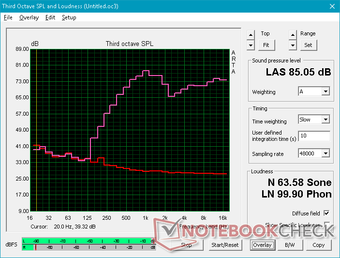
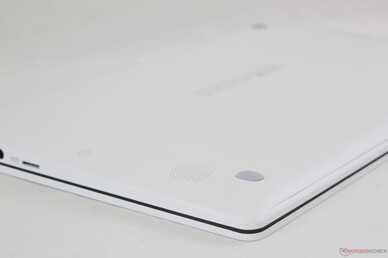
LG Gram 14Z980-U.AAW5U1 audio analysis
(±) | speaker loudness is average but good (78.2 dB)
Bass 100 - 315 Hz
(-) | nearly no bass - on average 23.7% lower than median
(±) | linearity of bass is average (11.6% delta to prev. frequency)
Mids 400 - 2000 Hz
(+) | balanced mids - only 3.9% away from median
(±) | linearity of mids is average (7% delta to prev. frequency)
Highs 2 - 16 kHz
(+) | balanced highs - only 1.8% away from median
(+) | highs are linear (4.6% delta to prev. frequency)
Overall 100 - 16.000 Hz
(±) | linearity of overall sound is average (20.4% difference to median)
Compared to same class
» 64% of all tested devices in this class were better, 8% similar, 27% worse
» The best had a delta of 5%, average was 18%, worst was 53%
Compared to all devices tested
» 53% of all tested devices were better, 8% similar, 39% worse
» The best had a delta of 4%, average was 24%, worst was 134%
Apple MacBook 12 (Early 2016) 1.1 GHz audio analysis
(+) | speakers can play relatively loud (83.6 dB)
Bass 100 - 315 Hz
(±) | reduced bass - on average 11.3% lower than median
(±) | linearity of bass is average (14.2% delta to prev. frequency)
Mids 400 - 2000 Hz
(+) | balanced mids - only 2.4% away from median
(+) | mids are linear (5.5% delta to prev. frequency)
Highs 2 - 16 kHz
(+) | balanced highs - only 2% away from median
(+) | highs are linear (4.5% delta to prev. frequency)
Overall 100 - 16.000 Hz
(+) | overall sound is linear (10.2% difference to median)
Compared to same class
» 7% of all tested devices in this class were better, 2% similar, 91% worse
» The best had a delta of 5%, average was 18%, worst was 53%
Compared to all devices tested
» 4% of all tested devices were better, 1% similar, 94% worse
» The best had a delta of 4%, average was 24%, worst was 134%
Energy Management
Power Consumption
The LG is surprisingly power efficient to explain its very long runtimes in the next section. Idling on desktop draws anywhere between 3 W and 7 W depending on the brightness setting and power profile compared to over 10 W on the XPS 13 or Yoga C930. At most, we're able to record 35.5 W when on maximum load (Prime95 + FurMark) from the small (~10.5 x 5 x 2.7 cm) 65 W AC adapter compared to 57 W on the Yoga C930 with the same CPU. LG could have probably gotten away with an even smaller adapter as this particular model demands very little.
Interestingly, power consumption when running Prime95 is relatively constant at about 34.8 W in contrast to its fluctuating clock rates as observed in our Stress Test section.
| Off / Standby | |
| Idle | |
| Load |
|
Key:
min: | |
| LG Gram 14Z980-U.AAW5U1 i5-8250U, UHD Graphics 620, SK Hynix SC313 HFS256G39TNF, IPS, 1920x1080, 14" | Dell XPS 13 9380 2019 i5-8265U, UHD Graphics 620, SK hynix PC401 HFS256GD9TNG, IPS, 3840x2160, 13.3" | Huawei Matebook X Pro i5 i5-8250U, GeForce MX150, Samsung PM961 MZVLW256HEHP, IPS, 3000x2000, 13.9" | Asus Zenbook 14 UX433FN-A6023T i7-8565U, GeForce MX150, Intel SSD 660p SSDPEKNW512G8, IPS, 1920x1080, 14" | Lenovo Yoga C930-13IKB i5-8250U, UHD Graphics 620, SK hynix PC401 HFS256GD9TNG, IPS, 1920x1080, 13.9" | Lenovo ThinkPad X1 Carbon 2018-20KGS03900 i5-8550U, UHD Graphics 620, Samsung SSD PM981 MZVLB512HAJQ, IPS, 2560x1440, 14" | |
|---|---|---|---|---|---|---|
| Power Consumption | -47% | -56% | -24% | -34% | -53% | |
| Idle Minimum * (Watt) | 2.7 | 4.8 -78% | 3.5 -30% | 2.6 4% | 3.3 -22% | 3.8 -41% |
| Idle Average * (Watt) | 6 | 8.6 -43% | 8.9 -48% | 5.6 7% | 6.8 -13% | 8.9 -48% |
| Idle Maximum * (Watt) | 6.5 | 10.4 -60% | 12.3 -89% | 7.3 -12% | 9.5 -46% | 11.9 -83% |
| Load Average * (Watt) | 32.5 | 37.9 -17% | 54.2 -67% | 47 -45% | 40.8 -26% | 47.5 -46% |
| Load Maximum * (Watt) | 35.5 | 48.5 -37% | 52.1 -47% | 61.8 -74% | 57 -61% | 52.5 -48% |
| Witcher 3 ultra * (Watt) | 42.4 |
* ... smaller is better
Battery Life
Battery capacity is identical to the Gram 13 and Gram 15 at 72 Wh. This is much larger than the batteries on most other subnotebooks which likely attributes to the long charging time. Battery life is impressive at 12 hours of real-world WLAN use to be hours longer than the typical Ultrabook. Perhaps unsurprisingly, the Gram 13 and Gram 15 also have very long runtimes.
Charging with the included AC adapter is very slow. Expect to wait around 3 hours when charging from empty to full capacity compared to 1.5 to 2 hours on most other Ultrabooks.
| LG Gram 14Z980-U.AAW5U1 i5-8250U, UHD Graphics 620, 72 Wh | Dell XPS 13 9380 2019 i5-8265U, UHD Graphics 620, 52 Wh | Huawei Matebook X Pro i5 i5-8250U, GeForce MX150, 57.4 Wh | HP Spectre x360 13t-ae000 i5-8550U, UHD Graphics 620, 60 Wh | Asus Zenbook 14 UX433FN-A6023T i7-8565U, GeForce MX150, 50 Wh | Lenovo Yoga C930-13IKB i5-8250U, UHD Graphics 620, 60 Wh | Lenovo ThinkPad X1 Carbon 2018-20KGS03900 i5-8550U, UHD Graphics 620, 57 Wh | |
|---|---|---|---|---|---|---|---|
| Battery runtime | -32% | -29% | -34% | -31% | -27% | -34% | |
| Reader / Idle (h) | 37.3 | 17.2 -54% | 20.7 -45% | 23.9 -36% | 22.1 -41% | ||
| WiFi v1.3 (h) | 12 | 8.3 -31% | 9.3 -22% | 7.1 -41% | 8.3 -31% | 9.2 -23% | 8.7 -27% |
| Load (h) | 2.7 | 2.4 -11% | 2.2 -19% | 2 -26% | 2.1 -22% | 1.8 -33% |
Pros
Cons
Verdict
Most consumers in the market for an Ultrabook might first look towards Dell, HP, Lenovo, Asus, or Acer. From our experience with the LG Gram 14, however, we believe it deserves the same attention as the likes of an XPS, Spectre, or ZenBook. The 14-inch LG solution offers two key advantages not available on most competitors: an extraordinarily light weight of just under 1 kg and an impressively long battery life of well over 10 hours. These highlights alone may be enough to attract users who are constantly on the move and find 13-inch screens to be too small.
There is a list of drawbacks and many of them are a consequence of keeping the weight as low as possible. For one, the Gram 14 lacks options commonly found on other Ultrabooks including Thunderbolt 3, NVMe, touchscreen, matte panel, 4K UHD, Gorilla Glass, and discrete graphics. The absence of Gorilla Glass reinforcement in particular means a very flexible lid that's more prone to damage. The below average CPU performance, slow charging, and difficult serviceability hinder the longevity of the system. This is more of an Ultrabook for travelers rather than an office workhorse frequently connected to docking stations and external monitors.
The LG Gram 14 is an unsung and underappreciated Ultrabook. Users who have no desire for many of the high-end features or connectivity options commonly found on other flagship Ultrabooks will find a lot to like about the super-light Gram. Power users and digital artists, however, will want something with more CPU and GPU horsepower.
LG Gram 14Z980-U.AAW5U1
- 04/05/2019 v6 (old)
Allen Ngo




